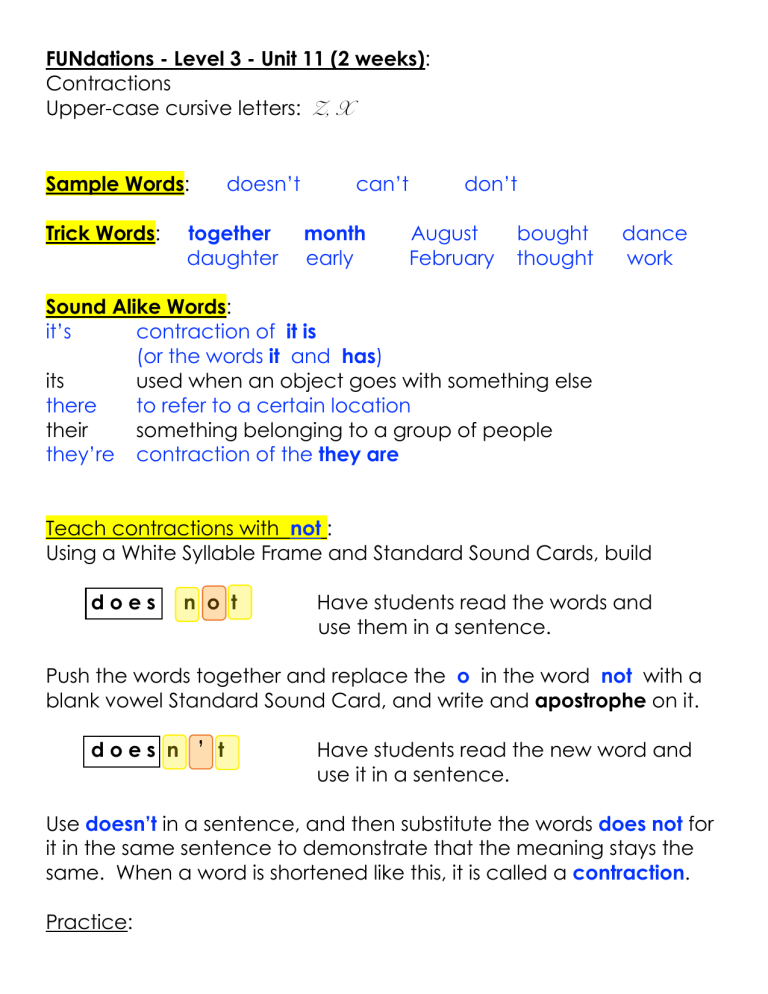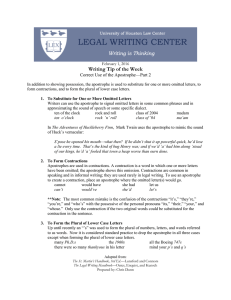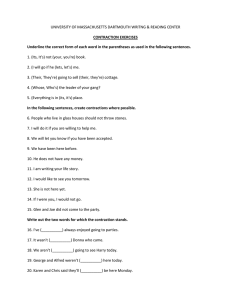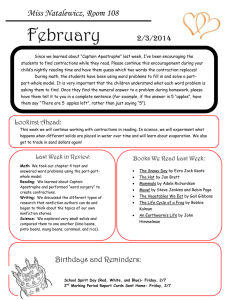
FUNdations - Level 3 - Unit 11 (2 weeks): Contractions Upper-case cursive letters: Z, X Sample Words: Trick Words: doesn’t together daughter can’t month early don’t August February bought thought dance work Sound Alike Words: it’s contraction of it is (or the words it and has) its used when an object goes with something else there to refer to a certain location their something belonging to a group of people they’re contraction of the they are Teach contractions with not : Using a White Syllable Frame and Standard Sound Cards, build does n o t Have students read the words and use them in a sentence. Push the words together and replace the o in the word not with a blank vowel Standard Sound Card, and write and apostrophe on it. ‘ does n t Have students read the new word and use it in a sentence. Use doesn’t in a sentence, and then substitute the words does not for it in the same sentence to demonstrate that the meaning stays the same. When a word is shortened like this, it is called a contraction. Practice: Write the words should, could, and would on a Syllable Frame, and make the word not with the Standard Sound Cards. Have a student replace the o in not with an apostrophe, and read the word. Student Notebook Level 3, Spelling Rules, Making Contractions, pg 40. Teach contractions with is : Using a White Syllable Frame and Standard Sound Cards, build what i s Have students read the words and use them in a sentence. Push the words together and replace the i in the word is with a blank vowel Standard Sound Card, and write and apostrophe on it. ‘ what s Have students read the new word and use it in a sentence. What is your name? What’s your name? Practice: Change the words there is, here is, and who is to contractions Have students replace the i in is with and apostrophe, and read the words. Student Notebook Level 3, Spelling Rules, Making Contractions, pg 41. Teach contractions can’t, mustn’t, won’t and don’t : Make the word doesn’t with White Syllable Frame and Standard Sound Cards ‘ does n t Have students read the word use it a sentence. The apostrophe replaced the o. Some contractions are a little tricky: must n ‘ must n o t t The contraction is pronounced /musn’t/ and that we do not pronounce the t in must. The next contraction is special too: n ‘ can t ‘ can n o t can t Replace the o with an apostrophe. Tell the students that the n is also removed. The apostrophe replaces both the n and the o . Write the word can’t on the board and have students use it in a sentence. Entry in Student Notebook Level 3, Vocabulary Section, pg 60. This contraction is very different: n ‘ will t wo n ‘ will n o t t “Willn’t sounds very funny.” We need to get rid of the ill and change it to an o . Use both will not and won’t in a sentence. Lastly, change do not to don’t. Point out the don’t rhymes with won’t - the first word no longer sounds like do . Student Notebook Level 3, Spelling Rules, Making Contractions, pg 40. Entry in Student Notebook Level 3, Vocabulary Section, pg 81. Teach contractions will: Using a White Syllable Frame and Standard Sound Cards, build he w i l l Have students read the words and use them in a sentence. Push the words together and replace the wi in the word will with a blank vowel Standard Sound Card, and write and apostrophe on it. ‘ he l l Have students read the new word and use it in a sentence. Use he’ll in a sentence, and then substitute the words he will for it in the same sentence to demonstrate that the meaning stays the same. When a word is shortened like this, it is called a contraction. Practice doing the same with the words: she will she’ll they will they’ll Teach contractions are: Using a White Syllable Frame and Standard Sound Cards, build they a r e Have students read the words and use them in a sentence. Push the words together and replace the a in the word are with a blank vowel Standard Sound Card, and write and apostrophe on it. ‘ they r e Have students read the new word and use it in a sentence. Use they’re in a sentence, and then substitute the words they are for it in the same sentence to demonstrate that the meaning stays the same. When a word is shortened like this, it is called a contraction. Practice doing the same with the words: we are we’re you are you’re Teach contractions would: Using a White Syllable Frame and Standard Sound Cards, build w o u l d I Have students read the words and use them in a sentence. Push the words together and replace the woul in the word would with a blank vowel Standard Sound Card, and write and apostrophe on it. ‘ I d Have students read the new word and use it in a sentence. Use I’d in a sentence, and then substitute the words I would for it in the same sentence to demonstrate that the meaning stays the same. When a word is shortened like this, it is called a contraction. Practice doing the same with the words: we would we’d she would she’d Teach contractions have: Using a White Syllable Frame and Standard Sound Cards, build we h a v e Have students read the words and use them in a sentence. Push the words together and replace the ha in the word have with a blank vowel Standard Sound Card, and write and apostrophe on it. ‘ we v e Have students read the new word and use it in a sentence. Use we’ve in a sentence, and then substitute the words we have for it in the same sentence to demonstrate that the meaning stays the same. When a word is shortened like this, it is called a contraction. Practice doing the same with the words: they have they’ve you have you’ve Teach contractions has: Using a White Syllable Frame and Standard Sound Cards, build it h a s Have students read the words and use them in a sentence. Push the words together and replace the ha in the word has with a blank vowel Standard Sound Card, and write and apostrophe on it. ‘ it s Have students read the new word and use it in a sentence. Use it’s in a sentence, and then substitute the words it has for it in the same sentence to demonstrate that the meaning stays the same. When a word is shortened like this, it is called a contraction. Practice doing the same with the words: he has he’s she has she’s Teach contractions had: Using a White Syllable Frame and Standard Sound Cards, build h a d I Have students read the words and use them in a sentence. Push the words together and replace the ha in the word had with a blank vowel Standard Sound Card, and write and apostrophe on it. ‘ I d Have students read the new word and use it in a sentence. Use I’d in a sentence, and then substitute the words I had for it in the same sentence to demonstrate that the meaning stays the same. When a word is shortened like this, it is called a contraction. Practice doing the same with the words: they had they’d we had we’d Entry contractions in Student Notebook Level 3, Vocabulary Section. Teach contractions let’s and I’m: Using a White Syllable Frame and Standard Sound Cards, build let u s Have students read the words and use them in a sentence. Push the words together and replace the u in the word us with a blank vowel Standard Sound Card, and write and apostrophe on it. ‘ let s Have students read the new word and use it in a sentence. Use let’s in a sentence, and then substitute the words let us for it in the same sentence to demonstrate that the meaning stays the same. When a word is shortened like this, it is called a contraction. Using a White Syllable Frame and Standard Sound Cards, build a m I Have students read the words and use them in a sentence. Push the words together and replace the a in the word am with a blank vowel Standard Sound Card, and write and apostrophe on it. ‘ I m Have students read the new word and use it in a sentence. Use I’m in a sentence, and then substitute the words I am for it in the same sentence to demonstrate that the meaning stays the same. When a word is shortened like this, it is called a contraction. Find let’s and I’m in the Spelling Section of the Student Notebooks. Circle or highlight the “special case” contractions won’t, don’t, let’s and I’m on the bottom of page 40. Word of the Day: won‘t will not contraction of will not can‘t can not contraction of can not we‘re we are contraction of we are I‘m I am contraction of I am FUN-L3-U11 review words: (highlighted words appear in the Unit Test) does not doesn’t they are they’re they will they’ll they have they’ve they had they’d should have should’ve what is what’s we are we’re I would I’d you have you’ve she had she’d its their there must not mustn’t you are you’re we would we’d it has it’s let us let’s we’d month you’ll can not can’t he will he’ll she would she’d he has he’s I am I’m shopping together hasn’t will not won’t she will she’ll we have we’ve I had I’d did not didn’t struggling FUNdations - Level 3 - Unit 11 Test - 25 points Sounds (4 points total) DO NOT SAY RED WORD PROMPT, JUST THE SOUND /ō/ /ē/ / r/ /ü/ e home Pete her suit o - e, o, oa, oe e - e, e, y, i, ee, ey, ei, ea, ie er, ir, ur, ar, or u - e, u, ou, oo, ui, ue, ew Sound Alike (4 points total) its The dog buried its bone in the yard. their Is this their house? they’re They’re on vacation. there She was sitting right there. Words (spelling 5 points AND two words 5 points totals) Sentences (trick words 2 points and spelling words 5 points) Test direction - underline contractions - 0 points.



